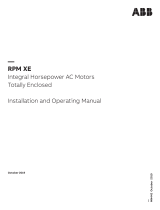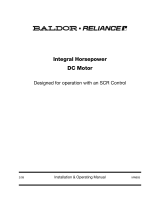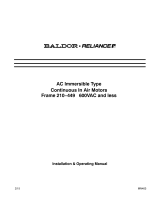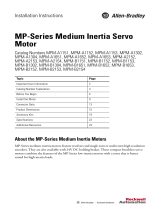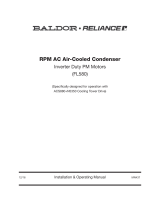Page is loading ...

Installation & Maintenance 1MS1240
BSM Motor Quick Start Guide
Safety Notice Be sure to read and understand all of the Safety Notice statements in MN1240. A copy is available at:
http://www.baldor.com/support/product_manuals.asp
Before you install, operate or perform maintenance, become familiar with the following:
• NEMA Publication ICS16, Motion/Position Control Motors; Controls; and Feedback Devices.
• The National Electrical Code
• Local codes and Practices
General Notes
Electrical Noise Prevention
Electro Magnetic Interference (EMI), commonly called “electrical noise” may adversely affect motor performance
by introducing stray signals. Effective techniques to reduce or prevent EMI include AC power filters, cable shielding,
separating signal wires from power wires and good grounding techniques.
Effective AC power filtering can be achieved by using properly installed “Isolated AC Power Transformers” or “AC Line
Filters”. Other techniques are:
• Install motor cables and signal wires in separate conduits.
• Do not route motor cables and signal wires in parallel. Separate cables by at least 1 ft (0.3m) for every 30 ft (9.1m)
of run.
• Cross signal and power wires at 90 degree angles to prevent inductive noise coupling.
• Do not route signal wires over the vent openings of the servo drives.
• Ground all equipment using a single point ground system.
• Keep wires as short as possible.
• Ground both ends of the feedback cable and use twisted pair wires.
• Use shielded motor cables to prevent EMI to other equipment.
Optional Holding Brake
CAUTION: Do not use the holding brake to stop motion. This will cause premature brake wear and failure.
The brakes are not designed to stop a rotating load. The servo drive inputs should always be used
to stop motor shaft rotation.
Holding brakes are offered as options for servo motors. These brakes are designed to hold the motor shaft at 0 RPM (to
rated brake holding torque). The purpose of the holding brake is to hold the servo axis when power to the machine is
turned off. The holding brake uses the “electric release” principle. Applying 24VDC (or 90VDC for some larger brakes) to
the brake causes the brake to release and let the motor shaft rotate.
Loss of power causes the brake to hold the motor shaft. The machine controller controls the holding brake.
This ensures correct On and Off switching sequence.
WARNING: The holding brake alone does not guarantee personnel safety. Use structural measures such as
protective fences or a second brake to secure personnel safety.
Shaft Loads
The motors can be damaged by excessive shaft loads. This may shorten the motors service life. The motor warranty
is also voided for excessive shaft load related failures. The maximum allowable radial force (F radial max) depends
on the shaft load. It is determined by (distance x force) and the output shaft design (plain shaft or shaft with keyway).
When motor shaft has both a radial load and an axial load, axial load rating = 44% of radial load rating listed. Should
questions arise, reference the full section in MN1240 for Radial Load Capacity graphs or contact Baldor.
Life Determination
A life estimate is a calculated, statistical expectancy and is defined as the length of time, or the number of revolutions,
until fatigue develops. This life depends on many different factors such as loading, speed, lubrication, operating
temperature, contamination, plus other environmental factors. Statistical calculation estimates are based upon L10 life.
This is the life that 90 percent of a group, of apparently identical parts, will reach or exceed. Typical bearing radial load
capacity curves presented in the literature are based upon bearing L10 life of 20,000 hours.
See MN1240 and 9AKK106417 for more information.
Safety Notice:
WARNING: Be sure that you are completely familiar with the safe operation of this equipment. Refer to
MN1240. This equipment may be connected to other machines that have rotating parts or parts
that are controlled by this equipment. Improper use can cause serious or fatal injury. Only qualified
personnel should attempt the start-up procedure or to operate or troubleshoot this equipment.
WARNING: Guards must be installed for rotating parts such as couplings, pulleys, external fans, and unused
shaft extensions, should be permanently guarded to prevent accidental contact by personnel.
Accidental contact with body parts or clothing can cause serious or fatal injury.
WARNING: This equipment may be connected to other machinery that has rotating parts or parts that are
driven by this equipment. Improper use can cause serious or fatal injury. Only qualified personnel
should attempt to install operate or maintain this equipment.
WARNING: Do not by-pass or disable protective devices or safety guards. Safety features are designed to
prevent damage to personnel or equipment. These devices can only provide protection if they
remain operative.

2 Installation & Maintenance MS1240
Safety Notice: Continuned
WARNING: Thermostat contacts automatically reset when the motor has slightly cooled down. To prevent
injury or damage, the control circuit should be designed so that automatic starting of the motor is
not possible when the thermostat resets.
WARNING: Do not touch electrical connections before you first ensure that power has been disconnected.
Electrical shock can cause serious or fatal injury.
WARNING: Be sure the system is properly grounded before applying power. Electrical shock can cause serious
or fatal injury.
WARNING: Surface temperatures of motor enclosures may reach temperatures which can cause discomfort
or injury to personnel accidentally coming into contact with hot surfaces. Protection should be
provided by the user to protect against accidental contact with hot surfaces. Failure to observe this
precaution could result in bodily injury.
Installation
Installation should conform to the National Electrical Code (or local codes and practices where appropriate). When
other devices are coupled to the motor shaft, be sure to install protective devices to prevent accidents. Some protective
devices include, coupling, belt guard, chain guard, shaft covers etc. These protect against accidental contact with
moving parts. Machinery that is accessible to personnel should provide further protection in the form of guard rails,
screening, warning signs etc.
Mounting
The motor must be securely installed to a rigid foundation or mounting surface to minimize vibration and maintain
alignment between the motor and shaft load. Failure to provide a proper mounting surface may cause vibration,
misalignment and bearing damage.
Alignment
Accurate alignment of the motor with the driven equipment is extremely important.
1. Direct Coupling
For direct drive, use flexible couplings if possible. Consult the drive or equipment manufacturer for more
information. Mechanical vibration and roughness during operation may indicate poor alignment. Use dial indicators
to check alignment. The space between coupling hubs should be maintained as recommended by the coupling
manufacturer.
2. End-Play Adjustment
The axial position of the motor frame with respect to its load is also extremely important. The motor bearings are
not designed for excessive external axial thrust loads. Improper adjustment will cause failure.
Guarding
After motor installation is complete, a guard of suitable dimensions must be constructed and installed around the
motor/gearmotor. This guard must prevent personnel from coming in contact with any moving parts of the motor or
drive assembly but must allow sufficient cooling air to pass over the motor.
Electrical Connections
Typical connections are shown in Figure 1. Note all wiring should be rated for 600 volts insulation. For wire color codes
and connector pinouts, please refer to the connection diagram included in the motor packaging.
Strain Relief (if required at terminal box)
The motor cable shield is terminated at the terminal box using a shielded strain relief connector, Figure 2.
1. Strip the outer shield from the cable to expose the conductors and shield.
2. Slip the strain relief components onto the cable in the order shown.
3. Fold the shield wires over the end of the contact carrier.
4. Slide the threaded adapter onto the contact carrier until the carrier is completely inserted into the adapter.
5. Slide the gasket into the contact carrier.
6. Slide the adapter cover onto the threaded adapter and tighten. As it is tightened, it compresses the gasket against
the cable to form the strain relief and securely hold the cable.
7. The assembly can be inserted into the terminal box and secured.

Installation & Maintenance 3MS1240
Figure 1 Motor Connections
AC MotorU
V W
G
Control
Feedback
Holding
Brake
Motor
Temperature
Switch
Shielded
Twisted Pair Wire
Shielded
Twisted Pair Wire
Feedback
Connector
Motor
Connector
Motor Ground Wire
Motor Temperature Input
Holding Brake Connector
Single Point
Ground
Shielded
Motor Cable
All wiring should have 600V rated insulation.
BSM Motor
Assembly
Threaded Adapter Gasket Adapter CoverContact Carrier
Shielded Cable
Assemble Parts onto Cable
Assembled
Fold Shield wires over Contact Carrier
Wire Leads
Shield Jacket
Figure 2 Cable Connector Assembly
Note: Only the outer shields should be connected on both ends. If an inner shield is used, it should be connected
on one end only. Refer to your controls installation manual.
Note: It is recommended that the motor brake leads are connected through an external relay or isolated supply to
help reduce electrical noise. Refer to your controls installation manual.
Note: Optional equipment. Not included unless specified.

Baldor Electric Company
P.O. Box 2400 Fort Smith, AR 72902-2400 USA Ph: (1) 479.646.4711, Fax: (1) 479.648.5792
www.baldor.com
© Baldor Electric Company
MS1240
All rights reserved. Printed in USA
1/16
*MS1240-0116*
/
